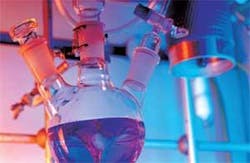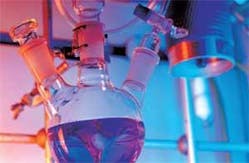Rising oil and gas prices have made those basic commodities increasingly valuable to countries with substantial proven reserves and attractive exploration prospects. Even more value is added when a portion of those national resources can be used to manufacture petrochemical “building blocks” and finished products.
Not all countries are equipped to make the investment needed to build a petrochemical industry; Egypt is fortunate to have that capability. In addition, it has a petrochemical master plan that will increase the value of its petroleum reserves, serve a growing domestic market for petrochemical products, and provide new export revenue.
The same advantages that have helped build its oil and gas industrystrategic location, economic and political stability, a skilled workforcewill benefit Egypt’s developing petrochemical industry.
Plan summary
The Egyptian Petrochemicals Master Plan will be executed in three phases over 20 years at a total estimated cost of US$10 billion. Responsibility for implementing the development plan will fall to the Egyptian Petrochemicals Holding Co. (Echem), established in 2002 to carry out the Master Plan, and to encourage investment in the petrochemical industry.
Though the overall objectives are clear, two decades can see significant change in markets and in feedstock supply, so the plan is designed with the flexibility needed to accommodate those changes.
It will be continuously updated to reflect conditions in local and international markets and to ensure that execution of the plan is responding to real world situations. But as the plan stood in mid 2007, it included 24 projects and 50 production units, and will create almost 100,000 direct and indirect employment opportunities.
The first phase is on track to be completed in 2008. Phase II will continue through about 2015 and the final phase of the current plan will be complete in 2022.
Product slate
Products to be produced by Phase I of the plan include methanol, ammonia/urea, polystyrene, propylene/polypropylene, linear alkyl benzene and acrylic fiber. The first of three olefins complexesone to be built in each phaseis also part of the initial phase.
Most Phase I projects were on schedule in mid 2007. The acrylic fiber project at Alexandria went on stream in February 2006 with a capacity to produce up to 18,000 tons/year using polymerization technology. Total cost of the project was US$70 million. The plant is owned by the Birla Group, (60%); Sidi Kerir Petrochemicals Co. (Sidpec), 20%; Apicorp, 10% and Egyptian Saudi for Investment, 10%.
Other projects are under construction, including methanol, ammonia/urea, polystyrene, propylene/polypropylene, and linear alkyl benzene units. The olefin complex and a planned polyvinyl chloride expansion are still under development.
Phase II of the plan calls for units to produce terephthalic acid (TPA), polyester, ethoxylates, styrene and latex; and includes another methanol unit, the second olefins complex and an aromatics complex. Three Phase II projects were under development at mid 2007a polyester unit, the aromatics complex and the styrene unit.
Phase III plants will include a vinyl complex; additional capacity for styrene and latex; and expansion of the propylene/ polypropylene and linear alkyl benzene capacity.
Project activity
In late 2007, the linear alkyl benzene plant capable of producing up to 100,000 tons/year was nearing completion near Alexandria. Using the process supplied by UOP LLC, the plant is scheduled for startup in early 2008 at a total cost of about US$492 million.
Major shareholders in the project are National Investment Bank with 34%, and Echem and EGAS, each with about 21%. Other owners include EGPC, the Ministry of Finance and UniChema Group.
The propylene/polypropylene plant now under construction at Port Said will have a capacity of 400,000 tons/year of polypropylene when it comes on stream in the third quarter of 2009. The plant uses the Uhde GmbH process for high density polypropylene and a process from Basell AF for polypropylene.
Arab and private investors account for the largest ownership share at 48%. Other shareholders include Echem and Gasco, each with a 13% share and Oriental Petrochemicals Co./Oriental Weavers with a 26% share. Cost of the plant is estimated at US$750 million.
A new US$950 million methanol plant at Damietta will have a capacity to produce 1.3 million tons/year when it is completed in the first quarter of 2010. Shareholders include Methanex Corp., 60%; Echem, 12%; EGAS, 12%; Gasco, 9% and Apicorp, 7%.
Starting up at about the same time at Damietta will be an ammonia/urea plant now under construction with a capacity to produce 1.4 million tons/year of urea. Cost of the unit is about US$1.4 billion. The Uhde ammonia process is combined with a UOP carbon dioxide removal process. Both urea synthesis and urea granulation are done with a process supplied by Stamicarbon BV. Ownership of the project is shared by Agrium (60%), Echem (24%) and private investors.
At mid 2007, basic engineering was under way at Alexandria for a polystyrene plant that will produce up to 200,000 tons/year after it starts up in third quarter 2009. Feedstock for the plant, styrene monomer, will be imported during Phase I of the Master Plan but styrene capacity built in Phases II and III will eliminate the need for imports.
Shareholders in the US$150 million plant include Echem, 35%; Ministry of Finance, 20%; National Investment Bank, 20%; Petrojet, 15% and Enppi, 10%.
Construction of a polyester unit at Damietta with a capacity of 315,000 tons/year of polyethylene terephthalate (PET) has been approved by the joint venture shareholders. Startup is scheduled for fourth quarter 2009. Owners are South Asian Petrochemicals Ltd. (SAPL), 70%; Echem, 23%; and Enppi, 7%.
Under study is an aromatic complex that would be built at Suez or Alexandria to produce 500,000 tons/year of gasoline and 500,000 tons/year of paraxylene. Total investment would be about US$2 billion.
The ethane cracker under consideration for Damietta would produce 300,000 tons/year followed by ethylene processes. UGDC would provide the ethane feedstock for the plant, which is estimated to cost US$925 million. If the project goes ahead, it would begin operation in 2011.
At mid 2007, the feasibility study for the ethane cracker in Alexandria was being prepared. With a planned capacity of 400,000 tons/year, the cracker would be followed by polyethylene, styrene and polyvinyl chloride (PVC) production.
Refining/petrochemicals complex
In addition to the master petrochemical plan, Egypt intends to invest in other new downstream projects, including an integrated oil refinery and petrochemical complex. Also on the drawing board are dimethyl ether (DME) capacity of 200,000 tons/year at Damietta and bio-diesel manufacturing capability.
A feasibility study was in progress in mid 2007 for the refining and petrochemical complex project that would be built in three phases. The gas-to-propylene (GTP) plant would come first, followed by the oil refinery, then the petrochemicals units.
Adding value to Egypt’s natural gas resource by using it to produce propylene is the aim of the GTP plant. Design capacities are 470,000 tons/year of polypropylene, 185,000 tons/year of gasoline and 40,000 tons/year of LPG. Processes from Lurgi AG would convert gas to methanol, then convert methanol to propylene. A Basell process would convert propylene to polypropylene.
Total cost of the GTP plant is estimated at US$2.2 billion, with start up planned for 2010.
Phase two of the project under consideration is a 400,000-b/d refinery designed to produce 3.5 million tons of gasoline, 5.1 million tons of low sulfur diesel and 520 million tons of kerosene and jet fuel. Total investment is estimated to be US$8 billion and if sanctioned, the project would start up in 2012-2013.
The petrochemicals phase is aimed at producing basic and intermediate petrochemicals, including polyethylene, polypropylene, butene and its derivatives, butadiene and its derivatives, benzene and paraxylene. Feedstock would come from the units built in phase two. Estimated cost is US$6 billion.
Design capacities of the complex include:
- 1.2 million tons/year polyethylene;
- 810,000 tons/year polypropylene;
- 130,000 tons/year butene and its derivatives;
- 205,000 tons/year butadiene and its derivatives;
- 730,000 tons/year benzene;
- 1.2 million tons/year paraxylene.



